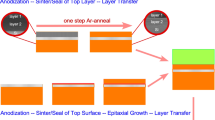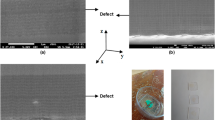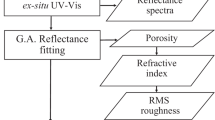Abstract
Silicon shows photo- and electroluminescence at visible wavelengths when chemically etched into a microporous network of ‘wires’ several nanometres thick1. This raises the possibility of a silicon-based optoelectronic technology. The luminescence properties may be understood on the basis of the injection or creation of electrons and holes in the interconnected network of wires which recombine radiatively with high efficiency1,2. Elucidating the electron-transport mechanisms has been held back by several difficulties, particularly that of making stable, high-quality contacts to the porous material. Here we report experiments that probe the conduction process using photoemission stimulated by hard-ultraviolet/X-ray synchrotron radiation, obviating the need for good electrical contacts. We find that the conductivity of porous silicon films is temperature-dependent, and that the films become insulating at low temperatures. We suggest that these results may be understood in terms of a percolation process occurring through sites in the porous network in which conductivity is thermally activated, and we postulate that this activation may be the consequence of a Coulomb blockade effect3,4 in the nanoscale channels of the film. This is consistent with our observation of optical ‘unblocking’ of conducting pathways. These results imply that the size distribution of the nanowires in the silicon backbone plays a key role in determining the conduction properties, and that porous-silicon light-emitting diodes may use only a small (and the least efficient) fraction of the material. Improvements in electroluminescence efficiency may be possible by taking into account the percolative nature of the conduction process.
This is a preview of subscription content, access via your institution
Access options
Subscribe to this journal
Receive 51 print issues and online access
$199.00 per year
only $3.90 per issue
Buy this article
- Purchase on Springer Link
- Instant access to full article PDF
Prices may be subject to local taxes which are calculated during checkout




Similar content being viewed by others
References
Canham, L. T. Silicon quantum wire array fabricaiton by electrochemical dissolution of wafers. Appl. Phys. Lett. 57, 1046–1048 (1990).
Hamilton, B. Porous silicon. Semicond. Sci. Technol. 10, 1187–1207 (1995).
Lee, P. A. Few electron nanostructures—a laboratory for studying strongly interacting systems. Physica B 189, 1–5 (1993).
Ali, D. & Ahmed, H. Coulomb blockade in a silicon tunnel junction device. Appl. Phys. Lett. 64, 2119–2120 (1994).
Sham, T. K. et al. Origin of luminescence from porous silicon deduced by synchrotron light induced optical luminescence. Nature 363, 332–334 (1993).
Pettifer, R. F. et al. X-ray excited optical luminescence (XEOL) study of porous silicon. Physica B 208 & 209, 484–486 (1995).
Himpsel, F. J., Heimann, P., Chiang, T. C. & Eastman, D. E. Geometry-dependent Si(2p) surface core-level excitations for Si(111) and Si(100) surfaces. Phys. Rev. Lett. 45, 1112–1117 (1980).
8. Schulz, M. Coulomb energy of traps in semiconductor space-charge regions. J. Appl. Phys. 74, 2649–2657 (1993).
Read, A. J. et al. First principles calculation of the electronic properties of silicon quantum wires. Phys. Rev. Lett. 69, 1232–1235 (1992).
Tsu, R. & Babic, D. Doping of a quantum dot. Appl. Phys. Lett. 64, 1806–1808 (1994).
Lehmann, V., Hofmann, F., Moller, F. & Gruning, U. Resistivity of porous silicon—a surface effect. Thin Film Solids 255, 20–22 (1995).
Pennelli, G. Transient voltage behaviour of free standing porous silicon layers. J. Appl. Phys. 80, 5116–5120 (1996).
Stauffer, D. & Aharony, A. Introduction to Percolation Theory(Taylor & Francis, London, 1994).
Chen, W. & Ahmed, H. Fabrication of and physics of 2 nm islands for single electron devices. J. Vac. Sci. Technol. B 13, 2883–2887 (1995).
Fraunhoff, S. T. et al. An extended quantum model for porous silicon formation. J. Electrochem. Soc. 142, 615–620 (1995).
Kanemitsu, Y., Uto, H., Matsumoto, Y., Futagi, T. & Mimura, H. Optical properties of free standing porous films. Mater. Res. Soc. Proc. 298, 265–268 (1993).
Aldao, C. M., Waddill, P. J., Benning, P. J., Capasso, C. & Weaver, J. H. Photovoltaic effects in temperature-dependent Fermi-level movement for GaAs (110). Phys. Rev. B 41, 6092–6095 (1990).
Alonso, M., Cimino, R. & Horn, K. Surface photovoltage effects in photoemission from metal-GaP (110) interfaces: importance for band-bending evaluation. Phys. Rev. Lett. 64, 1947–1950 (1990).
Author information
Authors and Affiliations
Corresponding author
Rights and permissions
About this article
Cite this article
Hamilton, B., Jacobs, J., Hill, D. et al. Size-controlled percolation pathways for electrical conduction in porous silicon. Nature 393, 443–445 (1998). https://doi.org/10.1038/30924
Received:
Accepted:
Issue Date:
DOI: https://doi.org/10.1038/30924
This article is cited by
-
Nanograin network memory with reconfigurable percolation paths for synaptic interactions
Light: Science & Applications (2023)
Comments
By submitting a comment you agree to abide by our Terms and Community Guidelines. If you find something abusive or that does not comply with our terms or guidelines please flag it as inappropriate.



